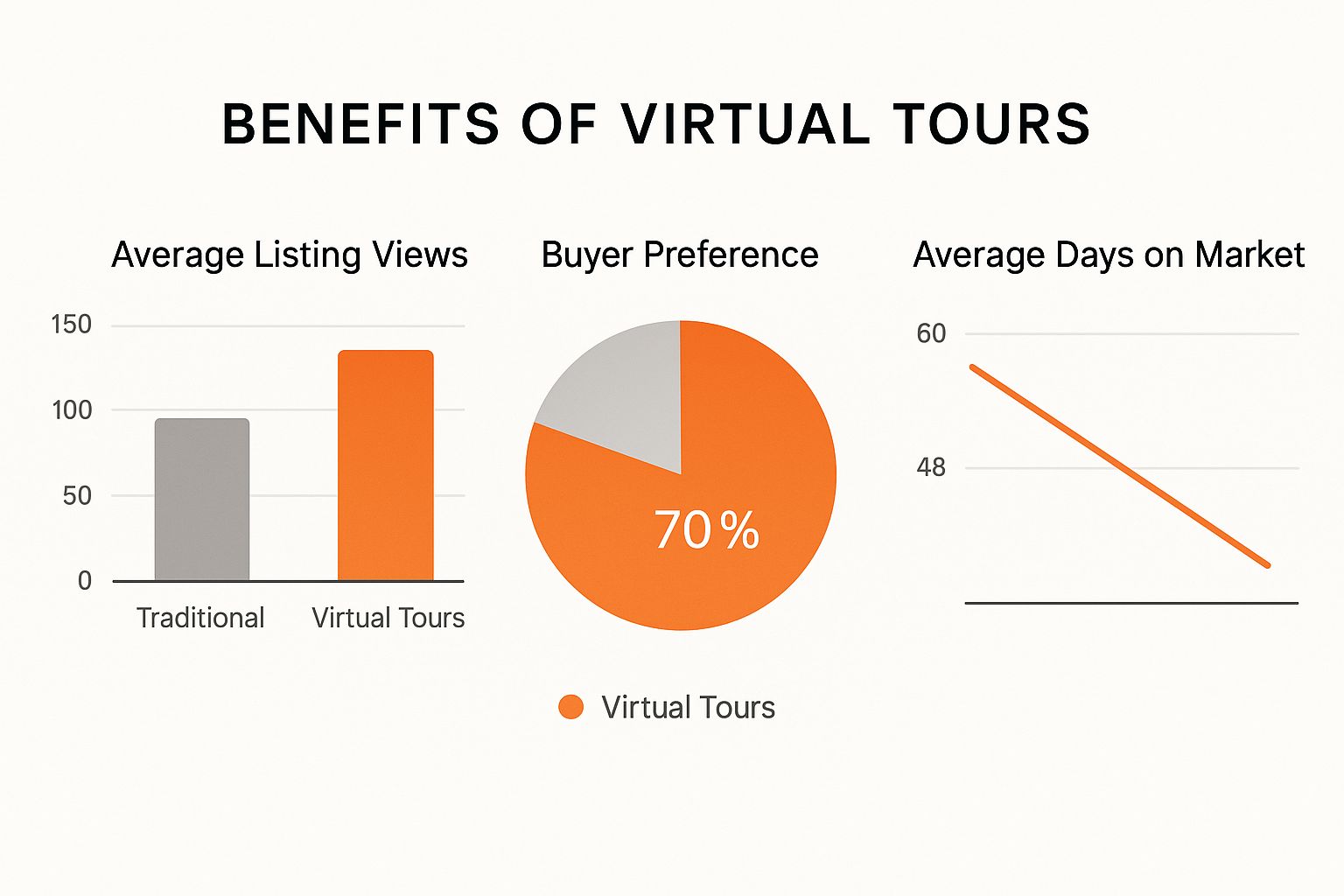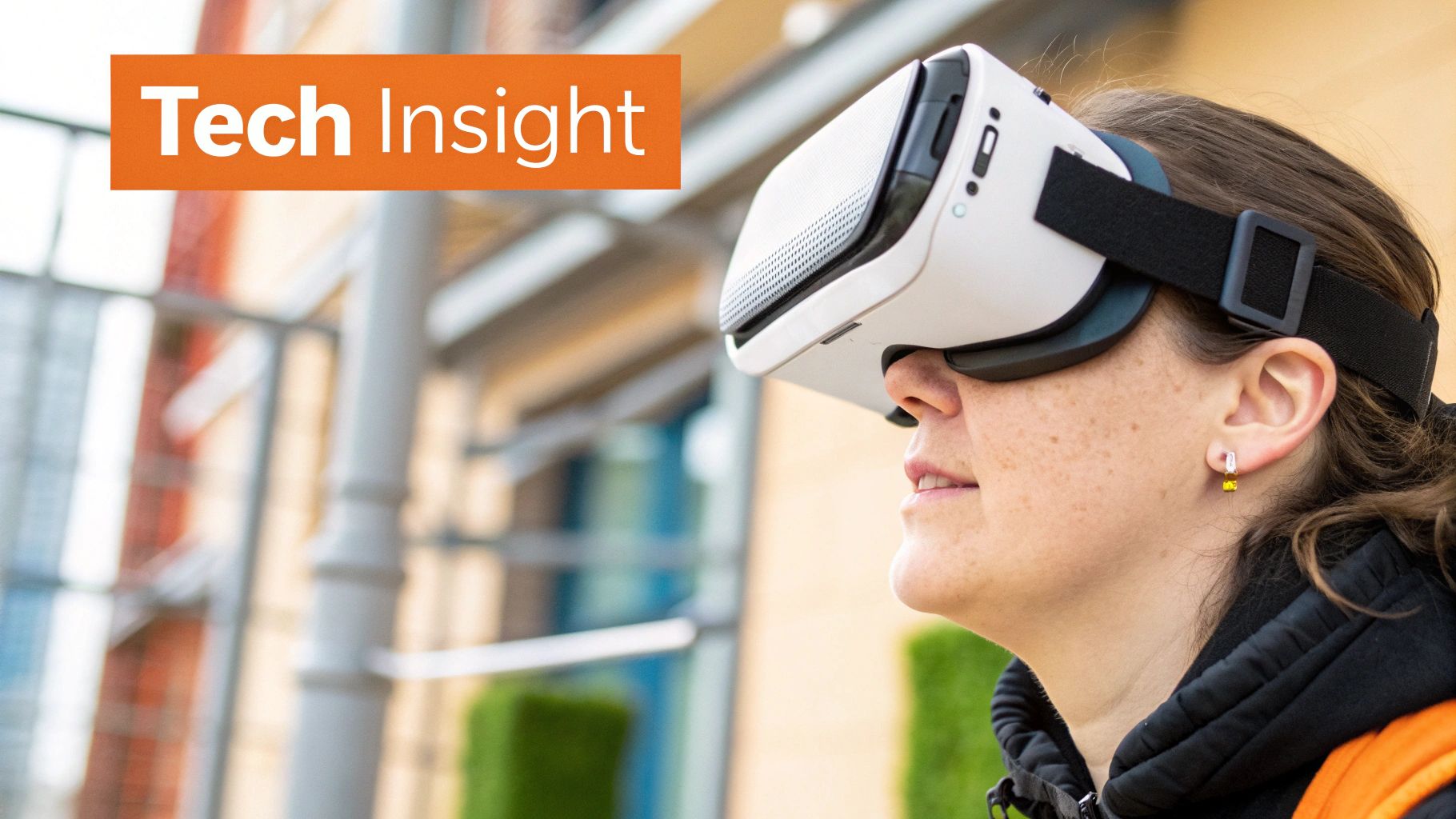Discover Engaging Real Estate Virtual Tours to Boost Sales
Explore stunning real estate virtual tours that captivate buyers and elevate your property marketing. Boost engagement today!
Why Real Estate Virtual Tours Are No Longer Optional

Image description
Remember listing photos? They were once a big deal, but now they’re just the minimum requirement. Buyers today expect a digital-first experience when searching for properties. Real estate virtual tours bridge the gap between online listings and actually visiting a property, offering convenience for everyone involved. This convenience leads to more qualified leads, less time wasted on unnecessary showings, and the chance to build an emotional connection with potential buyers before they even set foot inside.
How Virtual Tours Benefit Buyers and Sellers
Virtual tours offer a valuable first look for buyers, particularly those relocating or with packed schedules. They can explore properties from anywhere, at any time, narrowing down their options before committing to in-person visits. This saves time and resources, especially for those coming from out of town.
This pre-qualification process also helps sellers. It reduces the number of unproductive showings, letting agents concentrate on truly interested prospects. This ultimately leads to quicker sales.
Virtual tours also offer a more immersive experience than static photos. They allow buyers to get a feel for the flow and layout of a property, helping them imagine themselves living there. This creates an emotional connection that static images often miss. This emotional investment can be a key factor in a buyer’s decision.
The real estate industry has seen a significant shift toward virtual tours. By 2025, virtual tours and 360-degree imagery are expected to be standard practice. This allows buyers to explore properties remotely, and it’s driven by consumer demand. 90% of buyers are more likely to view a property with a virtual tour. 67% of homebuyers prefer virtual tours when looking at listings, and 95% are more likely to inquire about properties with them. The use of virtual tours in real estate marketing has greatly improved the online shopping experience, providing potential buyers with a more engaging way to explore properties before scheduling a visit. Find more detailed statistics here: https://www.photoup.net/learn/real-estate-virtual-tour-statistics. You might be interested in: How to create virtual tours.
Turning Virtual Tours Into Powerful Marketing Tools
Smart real estate professionals are using virtual tours not just as a showing tool, but as a core part of their marketing. Standing out in today’s competitive market is crucial. To maximize your ROI, you can use already created virtual tours and apply content repurposing strategies, as explained in this article. By incorporating virtual tours into social media campaigns, email marketing, and website listings, agents can reach a wider audience. This increased visibility leads to more leads and, ultimately, more sales.
The Numbers Don’t Lie: Virtual Tours Drive Real Results
Forget the hype. Let’s talk about the real impact of virtual tours in real estate. We’ll explore how they affect important metrics like days-on-market, final sale prices, and prospect engagement. We’ll also look at real-world examples of how virtual tours give properties a competitive edge.
Boosting Engagement and Reducing Time-on-Market
Virtual tours are essential in today’s real estate market. They allow potential buyers to easily explore properties anytime, from anywhere. This convenience leads to more qualified leads and less time spent on unproductive showings.
For example, buyers from out of town can get a good feel for a property before traveling for an in-person showing. This also helps sellers by minimizing disruptions from numerous showings.
The infographic below shows the positive impact of virtual tours on listing views, buyer preferences, and days on market.

Infographic about real estate virtual tours
As the infographic shows, listings with virtual tours get significantly more views, and more buyers prefer them. This leads to a much shorter time-on-market. A faster sales cycle means quicker returns for sellers and more closed deals for agents.
Let’s explore some data comparing traditional listings with those featuring virtual tours. The following table highlights the performance differences:
Virtual Tours vs. Traditional Listings: Performance Comparison | Performance Metric | Traditional Listings | Listings with Virtual Tours | Percentage Difference | |—|—|—|—| | Listing Views | 100 | 187 | +87% | | Time Spent on Listings | 1 minute | 5-10 minutes | +400-900% | | Days on Market | 60 days | 42 days (approx.) | -31% (approx.) | | Final Sale Price | $200,000 | $218,000 (approx.) | +9% (approx.) |
This table summarizes key performance differences between traditional listings and those enhanced with virtual tours. The data clearly shows that virtual tours significantly improve listing performance across the board.
Increasing Sale Prices and Creating Competitive Advantages
Virtual tours also boost final sale prices. By offering a more immersive experience, they help potential buyers connect emotionally with a property, often leading to higher offers.
This is especially helpful in competitive markets with multiple offers. A virtual tour can be what convinces a buyer to offer more. Increased engagement is crucial for driving interest and faster sales.
Listings with virtual tours receive 87% more views, and potential buyers spend 5-10 times longer engaging with them. Properties with virtual tours sell 31% faster and for 9% more. You can find more detailed statistics here: Virtual Tour Statistics.
This makes virtual tours an invaluable tool for agents seeking to distinguish their listings and attract more clients. This competitive advantage is vital in today’s market where buyers have so many choices.
Communicating the Value of Virtual Tours to Sellers
Some sellers might be unsure about investing in a virtual tour. Clearly communicating the return on investment is essential. Highlight the data showing faster sales, higher prices, and broader reach. Sharing success stories and testimonials from other sellers can be very persuasive.
The data shows that virtual tours are no longer a luxury; they are a necessary tool for maximizing a property’s selling potential.
Finding Your Perfect Fit: Virtual Tour Options Compared

Image description
Real estate virtual tours come in various forms. This section helps you choose the right type for your property listings, explaining the differences between several virtual tour formats. We’ll cover everything from basic 360-degree panoramas to immersive 3D walkthroughs, personalized guided video tours, and even cutting-edge VR experiences. Understanding these options is key to maximizing your marketing efforts.
360-Degree Panoramas: A Quick and Easy Solution
360-degree panoramas offer a single, static view of a space. They’re a cost-effective and simple way to create a virtual tour, perfect for properties with smaller budgets or straightforward layouts. Think of them as a significant step up from standard photos. While not as immersive as some other tour types, 360-degree panoramas still give potential buyers a better sense of the space than still images alone.
3D Virtual Tours: Immersive Exploration
3D virtual tours offer a more interactive experience. Viewers can virtually “walk” through the property, moving from room to room at their own pace. This creates a realistic feel for the property’s layout and flow, especially helpful for larger or more complex properties. Buyers can get a real sense of how the rooms connect and visualize themselves in the space.
Guided Video Tours: Personalized Showcases
Guided video tours add a personal touch. They combine the immersive elements of a walkthrough with narration by an agent. This allows agents to highlight key features and answer potential buyer questions proactively. Guided video tours can be especially effective for luxury properties or unique homes where storytelling adds value.
Full VR Experiences: The Next Level of Immersion
Full VR experiences represent the forefront of virtual tour technology. Using VR headsets, potential buyers can experience a property with unparalleled immersion. While still relatively new, this technology offers exciting possibilities for real estate marketing, forging deeper emotional connections between buyers and properties.
Comparing Virtual Tour Options
To help you choose, here’s a table summarizing the key aspects of each virtual tour type:
Comparison of Virtual Tour Technologies for Real Estate
| Tour Type | Average Cost | Equipment Required | Technical Difficulty | User Experience | Best For |
|---|---|---|---|---|---|
| 360° Panorama | Low | Basic 360° camera | Easy | Basic interactivity | Budget-conscious listings, simple layouts |
| 3D Virtual Tour | Moderate | Specialized camera/software | Moderate | Immersive exploration | Larger properties, complex layouts |
| Guided Video Tour | Moderate to High | Video camera, editing software | Moderate | Personalized showcase | Luxury properties, unique homes |
| Full VR Experience | High | VR camera, headsets | High | Maximum immersion | High-end properties, tech-savvy buyers |
This table highlights the differences in cost, technical needs, and user experience for each tour type. The best choice depends on several factors, including the type of property, your target audience, and your budget. A 360-degree panorama might be sufficient for a studio apartment, while a luxury listing could benefit from a guided video tour or a full VR experience. Think about what will showcase your property best and connect with your target buyer. More information can be found at ShowingTime+.
The Future of Real Estate Virtual Tours Is Already Here
https://www.youtube.com/embed/TEdxze71nTU
The real estate world is constantly evolving, and virtual tours are no exception. Are you ready for what’s next? New technologies are changing how properties are marketed. Think AI-powered tools highlighting a home’s best features and augmented reality (AR) apps that let buyers imagine their own furniture in empty rooms. Are these advancements truly revolutionary, or just fleeting trends?
Emerging Trends Shaping the Future of Virtual Tours
One significant trend is the growing use of AI in virtual tours. Artificial Intelligence can enhance image quality, personalize the tour experience, and even suggest virtual staging options. This creates a more tailored and efficient viewing, helping potential buyers zero in on what’s important to them.
AR is also becoming more common. It allows potential buyers to visualize furniture placement and renovations, eliminating the guesswork involved in picturing their lives in a new home. Check out our guide on realtor virtual tours. This personalized approach to virtual tours creates a more engaging and informative experience for buyers.
When exploring virtual tour options, consider the possibilities of interactive formats like 360 Views Of Cars. This can make your listings stand out.
From Gimmick to Game-Changer: Identifying Real Innovation
Not every new technology is a winner. Some might be interesting but lack practical value for everyday real estate deals. The key is separating true innovations from short-lived fads.
For example, while interactive floor plans and dollhouse views are helpful, AR apps allowing furniture placement offer a more impactful, personalized touch. Focusing on tech that truly enhances the buyer’s experience is key to long-term success.
The virtual tour market, particularly in real estate, is experiencing remarkable growth. Valued at USD 11.06 billion in 2024, it is projected to grow at a CAGR of 34.3% from 2025 to 2030. Real estate significantly contributes to this expansion. The increasing demand for immersive experiences lets buyers explore properties remotely. North America is expected to have a CAGR of 35% during this period due to its robust tech infrastructure and consumer interest in digital experiences. Learn more: https://www.grandviewresearch.com/industry-analysis/virtual-tour-market-report.
The Impact of Regional Adoption and Brokerage Integration
Different regions are embracing virtual tour technology at varying rates. Understanding these regional differences is vital for staying competitive. Leading brokerages are integrating virtual tours with other technologies to create a smoother buying process, far exceeding traditional methods in engagement, conversion, and client satisfaction. This marks a significant industry shift, positioning virtual tours as a critical element of real estate’s future.
From Decision to Implementation: Your Action Plan

Image description
Ready to boost your listings with the power of real estate virtual tours? This action plan guides you through the implementation process, whether you’re a budget-minded agent exploring DIY or seeking the polished look of professional services.
DIY vs. Professional Services: Choosing The Right Approach
The first decision is DIY or professional. DIY offers control and can be budget-friendly, especially for tech-savvy agents. Professional services often deliver higher quality, using specialized equipment and advanced editing software like Adobe Premiere Pro.
Think of it like painting your house yourself versus hiring professionals. One is cheaper upfront; the other yields better results and saves you time. Your choice depends on your budget, technical skills, and desired quality level.
Pre-Shoot Preparation: Setting The Stage For Success
Preparation is key, regardless of your approach. This includes decluttering, optimizing lighting, and staging key areas to showcase the property’s best features. For instance, ensure all lights are on and blinds are open for a bright, welcoming feel.
Think of it like prepping for an open house. You want to present the property in its best light. These details can significantly enhance the final product.
Common Mistakes To Avoid: Preventing Virtual Tour Pitfalls
Certain mistakes can hurt your virtual tours. Poor image quality, choppy transitions, and cluttered spaces can distract viewers and create a negative impression. Overlooking key selling points, like a renovated kitchen or spacious backyard, can leave buyers unimpressed.
These issues are easily avoided with careful planning and execution.
Post-Production Enhancements: Polishing Your Virtual Tour
Post-production elevates your virtual tour. This might involve adding background music, interactive elements, or incorporating property details and agent branding. Tools like Pedra simplify the process with AI-powered enhancements and user-friendly editing.
Like a fresh coat of paint, these final touches add polish and professionalism.
Integrating and Tracking: Maximizing Your Tour’s Impact
Finally, integrate your virtual tour into your marketing channels, from MLS listings to social media. Tracking tour performance is vital for understanding its effectiveness and making adjustments.
Monitoring metrics like view count and engagement time reveals what resonates with potential buyers. This data-driven approach helps refine your strategy and maximize impact. It’s like analyzing website traffic to optimize content for better results.
Maximizing Your ROI: Beyond Just Having a Virtual Tour
Simply having a virtual tour for your real estate listings isn’t enough. It’s the strategic implementation that truly makes a difference. Let’s explore how top-performing agents use virtual tours throughout the sales process to maximize their results.
Effective Promotion Strategies for Your Virtual Tours
Where do your qualified buyers spend their time online? Effective promotion means sharing your virtual tours on the platforms they frequent. This could include targeted social media ads on platforms like Facebook or Instagram, embedding tours directly into your website listings, or featuring them prominently in email marketing campaigns. The key is accessibility for the right audience.
Also, consider using analytics from your virtual tours. Understanding viewer behavior is crucial. Which parts of the tour are they engaging with most? This data offers valuable insights into buyer preferences, helping you refine your marketing strategy.
Clever Email Campaigns That Leverage Tour Analytics
Email marketing remains a powerful tool. Instead of just sending a link, integrate the virtual tour directly into the email itself. Highlight key features viewers are engaging with based on your tour analytics.
For example, if viewers consistently spend more time in the updated kitchen, emphasize this in your email messaging. This targeted approach turns casual interest into genuine leads.
This personalized experience increases the likelihood of converting viewers into serious prospects. It’s about showcasing what matters most to them based on their viewing habits.
Capturing and Nurturing Leads from Virtual Tours
Capturing leads generated through virtual tours is essential. Use lead capture forms within the tour or on its landing page. Once captured, nurture these leads with automated follow-up emails. Offer additional information, property details, or even personalized video messages. You might be interested in: How to master the ROI of virtual staging.
This automated system keeps potential buyers engaged and moves them through the sales funnel, turning casual browsers into qualified prospects ready to make an offer.
Automating Follow-Up for Maximum Conversion
Successful real estate teams combine virtual tours with automated follow-up systems. This creates a powerful lead nurturing strategy. Automated emails can provide property updates, neighborhood information, and even personalized mortgage pre-approval options, streamlining the buying process.
This approach not only saves you time but also provides a consistent and professional client experience. It demonstrates responsiveness and attention to their needs.
Top-producing agents understand that virtual tours are more than just a nice feature; they’re a powerful tool for driving sales. By implementing these strategies, you can transform your virtual tours from a passive viewing experience into an active lead generation engine.
Ready to create stunning virtual tours and automate your property marketing? Explore Pedra today and see how easy it is to transform your listings and accelerate your sales. Visit Pedra now.

Related Posts
3D Photography for Real Estate Guide
Explore our guide to 3D photography for real estate. Learn how immersive virtual tours can attract q...
Effective Copywriting for Real Estate to Sell Homes Fast
Discover expert copywriting for real estate that boosts property sales. Learn tips to craft compelli...
Top Floor Plan Creator Software of 2025 | Design with Ease
Explore the best floor plan creator software of 2025. Find intuitive tools and powerful features to ...